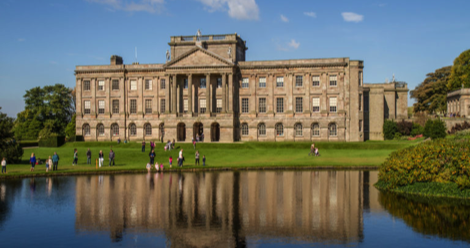
Literary Tourism: Jane Austen-Themed Destinations
We’re celebrating Jane Austen on this, the day of her death, with a bevy of posts about her work and legacy. See all the posts here.
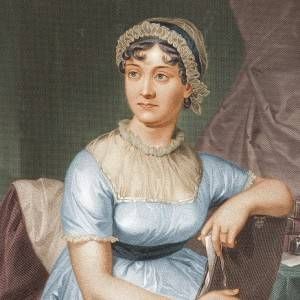
Jane Austen
Jane Austen wasn’t widely travelled, spending most of her life in the county of Hampshire. But today Austen tourism is a whole industry. There are multiple themed tours available (exhibits 1, 2, and 3), covering Austen’s homes and the settings from her novels, as well as the homes and lives of people only tangentially connected to the slightest bit of Jane. And with the 200th anniversary of Austen’s death this year, there are more Austen-related things to do than ever before.
If you’re interested in planning your own Austen-themed literary tour, or you just want to read about some places important to her life and work, I’ve collected a few of the biggest ones here. It seems possible to spend an entire month in the U.K. going to Austen-related places—if anyone out there is doing that, please bring me along!
Bath and Area
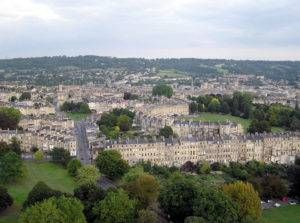
Image of Bath from Wikimedia. Public domain.
Austen set most of her novels in fictional rural communities or the genteel parts of London, but Bath is featured prominently in Persuasion and Northanger Abbey (and is, memorably, where Emma’s Mr. Elton meets his obnoxious wife). Austen herself lived in Bath from about 1801 to 1805.
- There is a Jane Austen Centre there today, with a museum about Austen’s life and work and even a tearoom.
- The city also recommends a free audio walking tour through the streets of Bath, the same ones Austen would have walked. It’s available for download here.
- You can take a day trip out to the village of Lacock, which was used as the setting for Meryton in the 1995 BBC version (the best one) of Pride and Prejudice.
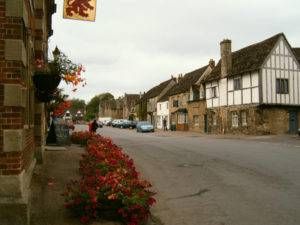
The village of Lacock. By Ettlz at the English language Wikipedia, CC BY-SA 3.0.
- And why not visit the famous Bath Assembly Rooms in hopes of meeting an eligible young lady or gentleman? Both Catherine Morland and Anne Elliot were quite familiar with the hope and heartbreak witnessed by these ornate walls.
Hampshire
Hampshire is a county with several Austen-related sites. She lived the first 25 years of her life in the village of Steventon, Hampshire, moving only upon her father’s retirement from the church. Sadly, the rectory they lived in no longer stands, but the village itself does.
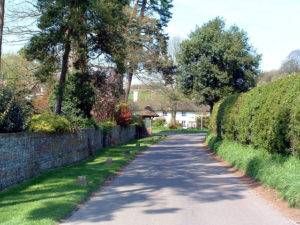
The village of Steventon. By Jeff Dodgson, CC BY-SA 2.0.
- The 12th-century Steventon church Austen and her family attended (where her father was rector) still stands and can be visited.
- Austen liked to walk and was a frequent letter writer, so while living in Steventon she often walked to the Wheatsheaf Hotel in North Waltham to pick up her mail. Today, the Hotel is a pub where you can enjoy a pint and a meal and pretend you’re waiting for a gossipy letter from a friend in London.
- After their time in Bath, Austen, her sister Cassandra, and their mother moved to Chawton, where Jane and Cassandra’s brother had offered them a cottage. That lovely cottage, where Austen wrote and revised many of her novels, is now the Jane Austen’s House Museum.
- Chawton House is a nearby manor that belonged to Edward Austen, Jane’s brother. It is now a library with a collection of early women’s writing—the kind of novelists Austen herself would have read, including Maria Edgeworth, Frances Burney, and many others.
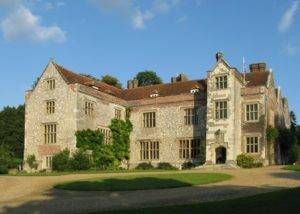
Chawton House. By Charles D P Miller from Basingstoke, United Kingdom – Chawton House, CC BY 2.0.
- Austen lived only eight years in Chawton before dying in Winchester at the age of 41. She was buried in Winchester Cathedral, where you can visit her grave.
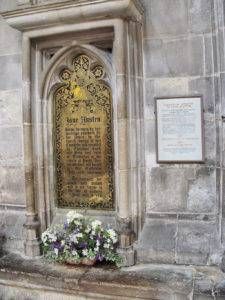
Jane Austen’s grave at Winchester Cathedral. By BKP (Own work) [CC BY-SA 3.0], via Wikimedia Commons.
Filming Locations
We Austen fans are lucky because her novels have been filmed so many times—giving us plenty of lavish estates to ogle. Quite a few of the grand houses where various Austen adaptations were filmed are open to the public. I’ve listed a few below, but note that there are many more to be visited. Most of these houses also have long and interesting histories and are worth a trip even outside their connection to Austen.
- The absolutely glorious estate of Lyme Park in the Peak District starred as Darcy’s family home, Pemberley, aka the property that convinces Elizabeth to marry him after all, in the 1995 Pride and Prejudice. Can’t say I blame her!
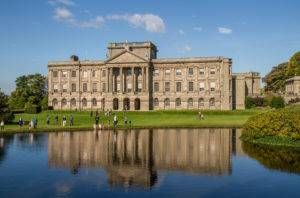
Lyme Park, now open to the public. By Julie Anne Workman – Own work, CC BY-SA 3.0.
- On the other side of the Peak District, you can visit Chatsworth House, which stood in for Pemberley in the 2005 Pride and Prejudice. Chatsworth is also mentioned in the novel as a house Elizabeth visited with her aunt and uncle before awkwardly running into Darcy at Pemberley. Like Lyme Park, it is impossibly gorgeous. And so is the Peak District in general, which Elizabeth travels through in the novel—there are all kinds of old houses, charming villages, and breathtaking vistas to see.
- Mompesson House in Salisbury (not far from Stonehenge) was used as a filming location in the 1995 Sense and Sensibility. It’s a classic 18th-century townhouse.
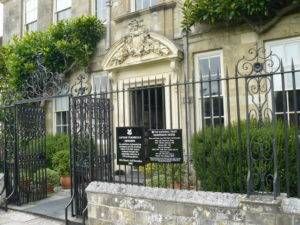
Mompesson House. By Chris Talbot, CC BY-SA 2.0.
- The 2009 BBC version of Emma was filmed on location at Squerryes Court, which stood in for Emma’s home, Hartfield. This 17th-century manor has been owned by the same family for almost 300 years. The house is not open to the public, but the family runs a vineyard with a tasting room.
Miscellaneous Jane Austen-Related Places
- As a single woman living with another single woman (her sister) and widow (her mother), Austen relied upon the kindness of friends and relatives. Luckily for her, many of them were well-off. Godmersham Park was owned by Austen’s brother Edward. Although it’s closed to the public, there is a nearby visitors’ centre and beautiful walk through the estate grounds.
- Anyone who has read Emma remembers the cringeworthy moment at Box Hill when Emma insults Miss Bates. This moment inspires Emma to examine her behaviour and resolve to act better in future. If you’re in need of your own Emma moment, or just want to check out the lovely view, Box Hill is still a popular tourist spot and not far from London. These days, it bustles with tourists and nearby cafes, but apparently the beauty of the view remains intact.
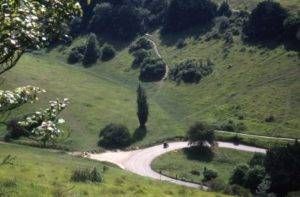
The view looking down from Box Hill. By Barry Shimmon, CC BY-SA 2.0.
Also In This Story Stream
- Blame Jane Austen for My Fanfiction Addiction
- 5 Contemporary YA Jane Austen Retellings
- Get Lost in Austen: 13 Adaptations for Jane Austen Fans
- Why EMMA is the Worst Jane Austen Novel
- 5 Excellent Jane Austen Comic Book Adaptations
- Giveaway: Jane Austen Penguin Clothbound Editions!
- From Pemberley to Trump Tower: Jane Austen Quotes Meet Trump Tweets
- The Queerness of Emma
- Don’t Dismiss Jane Austen as a Writer of “Silly Things”











